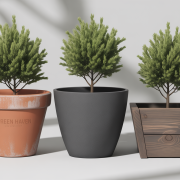Places with little to no rainfall and an annual high heat have little chance of growing and maintaining a lush lawn in the yard. They need to have Xeriscape Landscaping or the landscape of the desert.
To begin with, Desert Landscaping is no less than lush green vegetation landscaping. It is a stunning sight to behold, having all those unique colorations and native flora. Preparing your lawn for a desert-like landscape is nothing less than a pleasing visual experience.
One of the main advantages of this type of gardening is that it doesn’t require regular freshwater or irrigation supply. These plants are capable of withstanding intense heat and dryness for days.
In this article, interested readers can get to know more about this special gardening and its challenges.
Desert Landscaping – What are the Considerations?
Apart from the fact that this gardening needs less water, it still has some special considerations. Gardeners need to know the hardiness zones, the soil type, the natural sunlight-falling areas, the wind gusts, etc.
Besides that, the desert climate is something to be considered because of its extremities. One must know that the days are as hot as chilly the nights get. Therefore, one must know the lay of the land entirely before choosing the best plants or features to have in the garden.
Looking at the Top 3 Innovative Desert Gardening Ideas
Cacti or Succulents – what’s the best?
Most people confuse the two considering them to be the same. While both are inhabitants of the desert climate, they are not the same.
A cactus is a succulent plant. But, not all succulent plants in the desert are necessarily cacti. Succulent plants are basically those that can withstand extreme heat and scarcity of water as they store water in the stems and leaves. Besides, cacti also have thorns on their body surface instead of leaves.
Both cacti and other succulent plants are a great option to decorate your garden. The exciting thing about a cactus is that it produces beautiful, small, and colorful flowers.
Drought-tolerant Desert Flowers
Cacti and succulent plants aren’t the only vegetation in desert climatic regions. If you are looking for flowers, you can try the drought-tolerant plants that look decent in desert gardens.
The most common names are Russian Sagem, Sedums, Agastache, fountain grass, etc. Apart from these, some Mediterranean herbs have the same tolerance towards water scarcity, like Rosemary, Lavender, and Salvias.
Native Wildflowers
Did you know that there are plenty of wildflowers that survive and thrive happily in desert soils and climates?
One can try the coral plant, typically known as fountain bush or the firecracker plant. They look amazing with all the bright red lacy sprays of flora. Those looking for something extra bright and colorful can opt for Southwest natives like Mexican Gold Poppies, Desert Mallows, or the Desert Lupine. These are some of the best vegetation to try in your desert garden.
Final Thoughts
Desert Landscaping is one of the most dramatic gardening choices ever. Be it the unusual shapes of the succulent plants, the Cacti flowers, or the colorful angles of desert light along with stones and sand, it is a view worth watching. Look for companies providing desert gardening products to further decorate your yard.













Comments